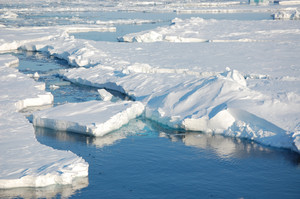Study: Impact Of Manmade 'Climate Change Is Observable In Arctic Sea Ice Already Today'
 The ongoing rapid retreat of Arctic sea ice is often interpreted as the canary in the mine for anthropogenic climate change. In a new study, scientists have now systematically examined the validity of this claim. They find that neither natural fluctuations nor self-acceleration can explain the observed Arctic sea-ice retreat. Instead, the recent evolution of Arctic sea ice shows a strong, physically plausible correlation with the increasing greenhouse gas concentration. For Antarctic sea ice, no such link is found – for a good reason.
The ongoing rapid retreat of Arctic sea ice is often interpreted as the canary in the mine for anthropogenic climate change. In a new study, scientists have now systematically examined the validity of this claim. They find that neither natural fluctuations nor self-acceleration can explain the observed Arctic sea-ice retreat. Instead, the recent evolution of Arctic sea ice shows a strong, physically plausible correlation with the increasing greenhouse gas concentration. For Antarctic sea ice, no such link is found – for a good reason.When scientists try to attribute some observed climatic change to a specific forcing, they usually use complex climate models. The scientists at Germany’s Max Planck Institute for Meteorology (MPI-M), however, decided on a different strategy as they set out to identify the main driver for the observed sea-ice loss in the Arctic. Dirk Notz, lead author of the study that was now published in the journal Geophysical Research Letters [1], explains why: “Sea ice is so thin that it reacts very sensitive to the large natural fluctuations of weather and climate that prevail in the Arctic. Because these fluctuations are inherently chaotic, their specific timing cannot be reproduced by standard climate models. Such models therefore aren’t necessarily the best tool to examine if natural fluctuations did cause the observed sea-ice loss.”
The scientists instead used a historical record that described the natural variations of sea-ice extent between the early 1950s and late 1970s. These natural fluctuations were then compared to the magnitude of fluctuations of the Arctic sea-ice cover as measured from satellites since the late 1970s. From such comparison, the scientists found only a minute chance that the recently observed extreme sea-ice minima simply happened by chance – and they could exclude self acceleration as the main driver for the observed sea-ice retreat. “Whenever we had a strong sea-ice loss from one year to the next, the ice cover always recovered somewhat in the following year,” explains Dirk Notz. This would not be the case if the sea-ice retreat were indeed self-accelerating.
Jochem Marotzke, Director at MPI-M and co-author of the study, describes what the scientists did next: “Having excluded natural fluctuations and self acceleration as the main driver for the sea-ice retreat, it was clear to us that some external driver was responsible for the observed sea-ice decline. We therefore set out to find an external driver that showed a physically plausible relationship with the observed sea-ice retreat.” The scientists examined, for example, the strength of solar radiation. “Here, a physically plausible link to the observed sea-ice retreat can only be established if solar radiation had increased in recent years.” However, solar radiation has slightly decreased in the past decades. Its fluctuations are therefore very unlikely to be the main driver of the observed sea ice loss. The scientists could not find a plausible link to changes in prevailing wind patterns, volcanic eruptions, oceanic heat transport, or cosmic rays, either.
“In the end, only the increase in greenhouse gas concentration showed a physically plausible link with the observed sea-ice retreat. We expect a decreasing sea-ice cover for increasing greenhouse gas concentration, which is exactly what is observed,” Notz explains. The physical link between greenhouse gas concentration and sea ice is quite straightforward, he adds: “Greenhouse gases increase the downwelling thermal radiation. This radiation, in turn, is the major player in the heat budget of Arctic sea ice.”
In the Antarctic, the situation is different. Here, the sea-ice cover is slightly increasing. This increase is clearly incompatible with greenhouse gas concentration being the main driver for the sea-ice evolution down South. The major reason for this discrepancy lies in the different land-mass distributions, the scientists find. In the Arctic Ocean, the ice is virtually locked by the surrounding land masses, and its extent is primarily governed by its melting and freezing. Therefore, greenhouse gases play such an important role up in the high North. In the Antarctic, by contrast, the sea ice is free to drift around in the open Southern Ocean. Hence, the ice extent there is primarily governed by the prevailing wind patterns. “Our results show that greenhouse gas concentration is currently not a major driver for sea-ice extent in the Southern Ocean, where winds and currents clearly are more important,” explains Marotzke. “In the land-locked Arctic Ocean, however, greenhouse gas concentration appears to play the dominating role for the observed sea-ice evolution”.
You can return to the main Market News page, or press the Back button on your browser.

